India: Exploring the Societal Shift from the Maharajas to Gandhi's Era
VerifiedAdded on 2022/10/09
|7
|1924
|38
Essay
AI Summary
This essay delves into the historical transformation of India, spanning from the era of the Maharajas to the influence of Mahatma Gandhi. It explores the diverse factors that shaped the Indian subcontinent, including its geography, languages, and climates. The essay examines the impact of various civilizations and empires, such as the Harappan civilization and the Mughal Empire, on the region's development. It further analyzes the influence of major religions like Hinduism, Buddhism, and Islam, and how they impacted the subcontinent before 1800. The essay also touches upon the impact of British colonialism. The essay highlights the key factors influencing the subcontinent, including its linguistic, climatic, and religious diversity. The essay concludes by emphasizing the need for adaptation and progress in the face of societal changes.
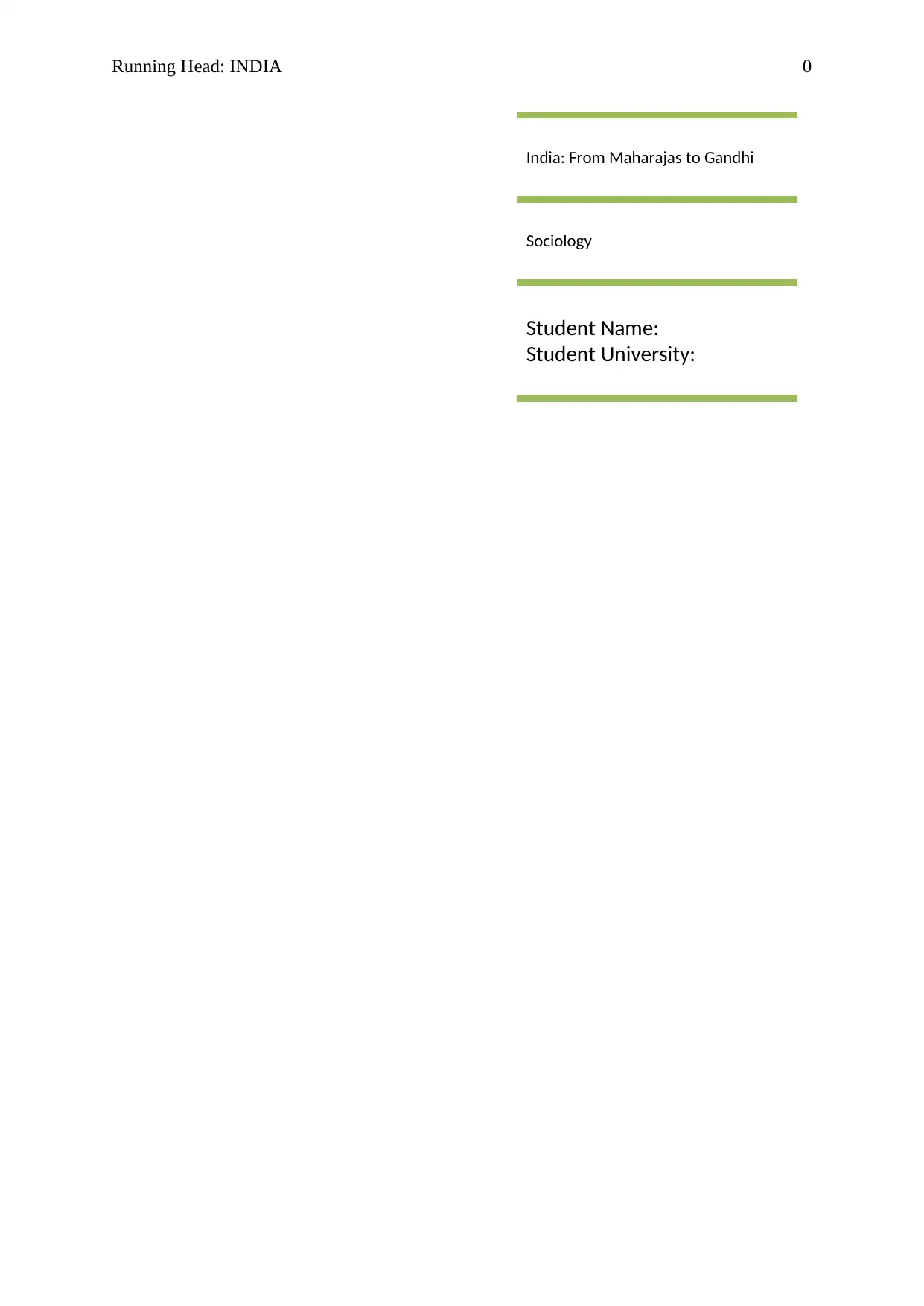
Running Head: INDIA 0
India: From Maharajas to Gandhi
Sociology
Student Name:
Student University:
India: From Maharajas to Gandhi
Sociology
Student Name:
Student University:
Secure Best Marks with AI Grader
Need help grading? Try our AI Grader for instant feedback on your assignments.
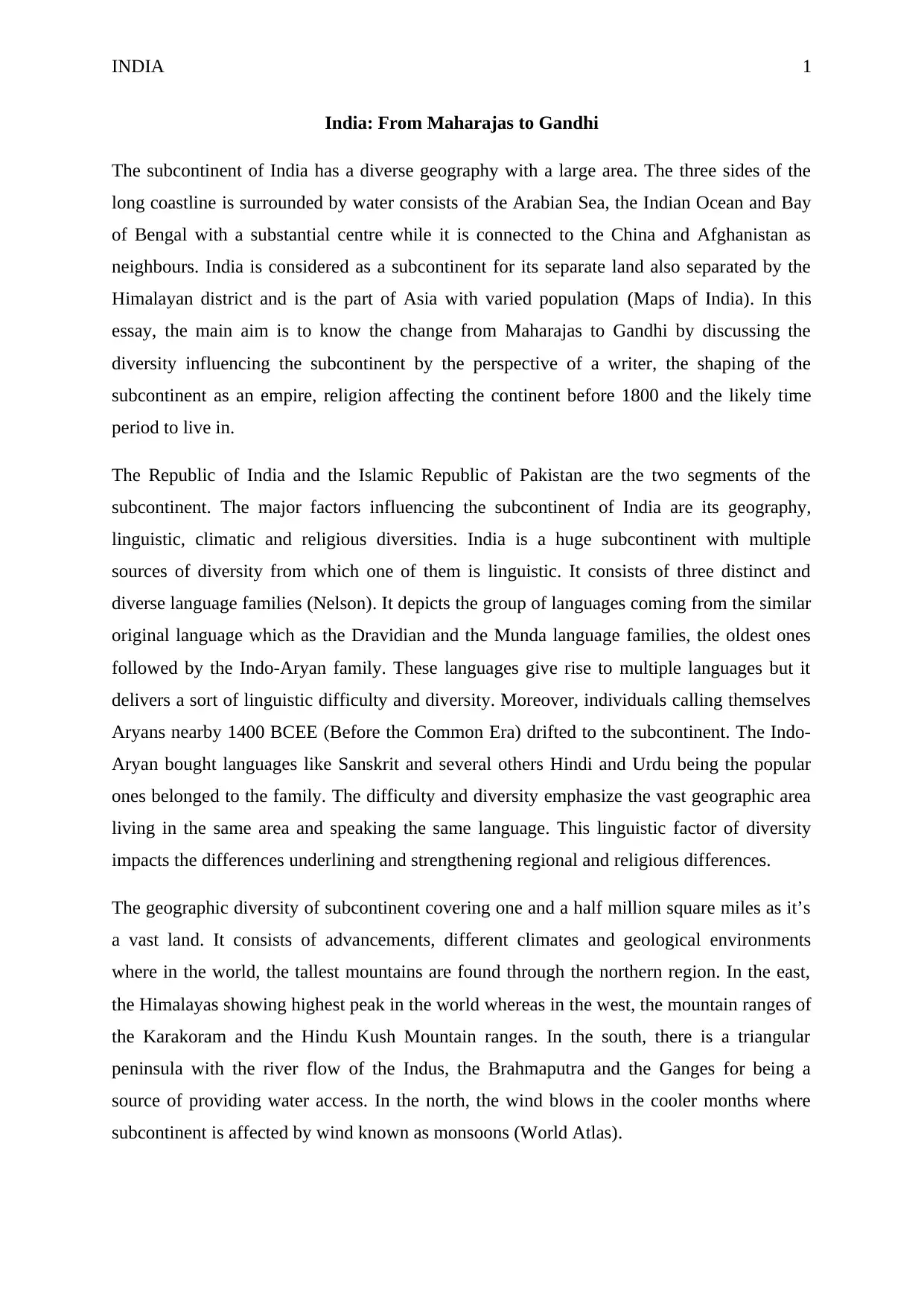
INDIA 1
India: From Maharajas to Gandhi
The subcontinent of India has a diverse geography with a large area. The three sides of the
long coastline is surrounded by water consists of the Arabian Sea, the Indian Ocean and Bay
of Bengal with a substantial centre while it is connected to the China and Afghanistan as
neighbours. India is considered as a subcontinent for its separate land also separated by the
Himalayan district and is the part of Asia with varied population (Maps of India). In this
essay, the main aim is to know the change from Maharajas to Gandhi by discussing the
diversity influencing the subcontinent by the perspective of a writer, the shaping of the
subcontinent as an empire, religion affecting the continent before 1800 and the likely time
period to live in.
The Republic of India and the Islamic Republic of Pakistan are the two segments of the
subcontinent. The major factors influencing the subcontinent of India are its geography,
linguistic, climatic and religious diversities. India is a huge subcontinent with multiple
sources of diversity from which one of them is linguistic. It consists of three distinct and
diverse language families (Nelson). It depicts the group of languages coming from the similar
original language which as the Dravidian and the Munda language families, the oldest ones
followed by the Indo-Aryan family. These languages give rise to multiple languages but it
delivers a sort of linguistic difficulty and diversity. Moreover, individuals calling themselves
Aryans nearby 1400 BCEE (Before the Common Era) drifted to the subcontinent. The Indo-
Aryan bought languages like Sanskrit and several others Hindi and Urdu being the popular
ones belonged to the family. The difficulty and diversity emphasize the vast geographic area
living in the same area and speaking the same language. This linguistic factor of diversity
impacts the differences underlining and strengthening regional and religious differences.
The geographic diversity of subcontinent covering one and a half million square miles as it’s
a vast land. It consists of advancements, different climates and geological environments
where in the world, the tallest mountains are found through the northern region. In the east,
the Himalayas showing highest peak in the world whereas in the west, the mountain ranges of
the Karakoram and the Hindu Kush Mountain ranges. In the south, there is a triangular
peninsula with the river flow of the Indus, the Brahmaputra and the Ganges for being a
source of providing water access. In the north, the wind blows in the cooler months where
subcontinent is affected by wind known as monsoons (World Atlas).
India: From Maharajas to Gandhi
The subcontinent of India has a diverse geography with a large area. The three sides of the
long coastline is surrounded by water consists of the Arabian Sea, the Indian Ocean and Bay
of Bengal with a substantial centre while it is connected to the China and Afghanistan as
neighbours. India is considered as a subcontinent for its separate land also separated by the
Himalayan district and is the part of Asia with varied population (Maps of India). In this
essay, the main aim is to know the change from Maharajas to Gandhi by discussing the
diversity influencing the subcontinent by the perspective of a writer, the shaping of the
subcontinent as an empire, religion affecting the continent before 1800 and the likely time
period to live in.
The Republic of India and the Islamic Republic of Pakistan are the two segments of the
subcontinent. The major factors influencing the subcontinent of India are its geography,
linguistic, climatic and religious diversities. India is a huge subcontinent with multiple
sources of diversity from which one of them is linguistic. It consists of three distinct and
diverse language families (Nelson). It depicts the group of languages coming from the similar
original language which as the Dravidian and the Munda language families, the oldest ones
followed by the Indo-Aryan family. These languages give rise to multiple languages but it
delivers a sort of linguistic difficulty and diversity. Moreover, individuals calling themselves
Aryans nearby 1400 BCEE (Before the Common Era) drifted to the subcontinent. The Indo-
Aryan bought languages like Sanskrit and several others Hindi and Urdu being the popular
ones belonged to the family. The difficulty and diversity emphasize the vast geographic area
living in the same area and speaking the same language. This linguistic factor of diversity
impacts the differences underlining and strengthening regional and religious differences.
The geographic diversity of subcontinent covering one and a half million square miles as it’s
a vast land. It consists of advancements, different climates and geological environments
where in the world, the tallest mountains are found through the northern region. In the east,
the Himalayas showing highest peak in the world whereas in the west, the mountain ranges of
the Karakoram and the Hindu Kush Mountain ranges. In the south, there is a triangular
peninsula with the river flow of the Indus, the Brahmaputra and the Ganges for being a
source of providing water access. In the north, the wind blows in the cooler months where
subcontinent is affected by wind known as monsoons (World Atlas).
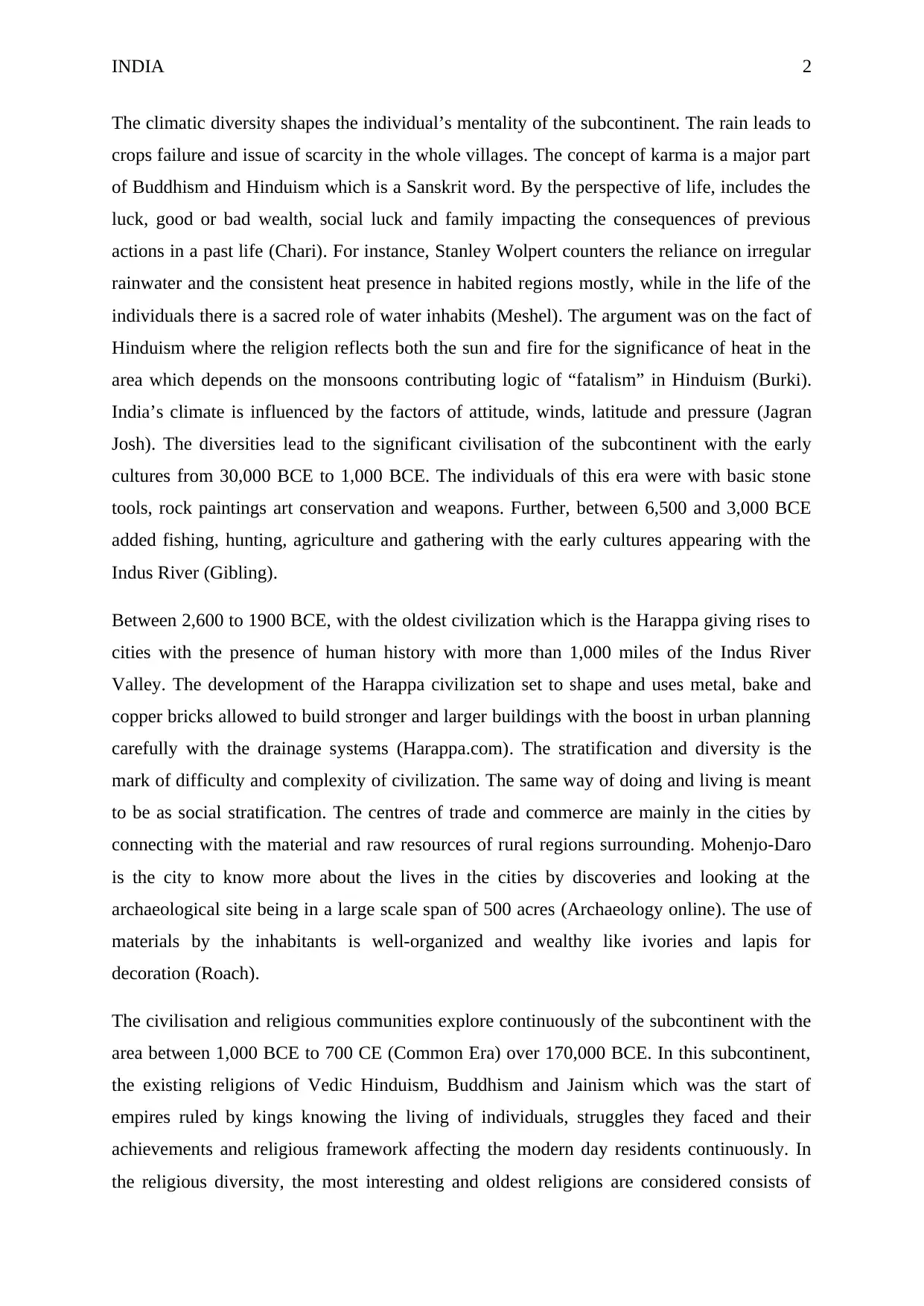
INDIA 2
The climatic diversity shapes the individual’s mentality of the subcontinent. The rain leads to
crops failure and issue of scarcity in the whole villages. The concept of karma is a major part
of Buddhism and Hinduism which is a Sanskrit word. By the perspective of life, includes the
luck, good or bad wealth, social luck and family impacting the consequences of previous
actions in a past life (Chari). For instance, Stanley Wolpert counters the reliance on irregular
rainwater and the consistent heat presence in habited regions mostly, while in the life of the
individuals there is a sacred role of water inhabits (Meshel). The argument was on the fact of
Hinduism where the religion reflects both the sun and fire for the significance of heat in the
area which depends on the monsoons contributing logic of “fatalism” in Hinduism (Burki).
India’s climate is influenced by the factors of attitude, winds, latitude and pressure (Jagran
Josh). The diversities lead to the significant civilisation of the subcontinent with the early
cultures from 30,000 BCE to 1,000 BCE. The individuals of this era were with basic stone
tools, rock paintings art conservation and weapons. Further, between 6,500 and 3,000 BCE
added fishing, hunting, agriculture and gathering with the early cultures appearing with the
Indus River (Gibling).
Between 2,600 to 1900 BCE, with the oldest civilization which is the Harappa giving rises to
cities with the presence of human history with more than 1,000 miles of the Indus River
Valley. The development of the Harappa civilization set to shape and uses metal, bake and
copper bricks allowed to build stronger and larger buildings with the boost in urban planning
carefully with the drainage systems (Harappa.com). The stratification and diversity is the
mark of difficulty and complexity of civilization. The same way of doing and living is meant
to be as social stratification. The centres of trade and commerce are mainly in the cities by
connecting with the material and raw resources of rural regions surrounding. Mohenjo-Daro
is the city to know more about the lives in the cities by discoveries and looking at the
archaeological site being in a large scale span of 500 acres (Archaeology online). The use of
materials by the inhabitants is well-organized and wealthy like ivories and lapis for
decoration (Roach).
The civilisation and religious communities explore continuously of the subcontinent with the
area between 1,000 BCE to 700 CE (Common Era) over 170,000 BCE. In this subcontinent,
the existing religions of Vedic Hinduism, Buddhism and Jainism which was the start of
empires ruled by kings knowing the living of individuals, struggles they faced and their
achievements and religious framework affecting the modern day residents continuously. In
the religious diversity, the most interesting and oldest religions are considered consists of
The climatic diversity shapes the individual’s mentality of the subcontinent. The rain leads to
crops failure and issue of scarcity in the whole villages. The concept of karma is a major part
of Buddhism and Hinduism which is a Sanskrit word. By the perspective of life, includes the
luck, good or bad wealth, social luck and family impacting the consequences of previous
actions in a past life (Chari). For instance, Stanley Wolpert counters the reliance on irregular
rainwater and the consistent heat presence in habited regions mostly, while in the life of the
individuals there is a sacred role of water inhabits (Meshel). The argument was on the fact of
Hinduism where the religion reflects both the sun and fire for the significance of heat in the
area which depends on the monsoons contributing logic of “fatalism” in Hinduism (Burki).
India’s climate is influenced by the factors of attitude, winds, latitude and pressure (Jagran
Josh). The diversities lead to the significant civilisation of the subcontinent with the early
cultures from 30,000 BCE to 1,000 BCE. The individuals of this era were with basic stone
tools, rock paintings art conservation and weapons. Further, between 6,500 and 3,000 BCE
added fishing, hunting, agriculture and gathering with the early cultures appearing with the
Indus River (Gibling).
Between 2,600 to 1900 BCE, with the oldest civilization which is the Harappa giving rises to
cities with the presence of human history with more than 1,000 miles of the Indus River
Valley. The development of the Harappa civilization set to shape and uses metal, bake and
copper bricks allowed to build stronger and larger buildings with the boost in urban planning
carefully with the drainage systems (Harappa.com). The stratification and diversity is the
mark of difficulty and complexity of civilization. The same way of doing and living is meant
to be as social stratification. The centres of trade and commerce are mainly in the cities by
connecting with the material and raw resources of rural regions surrounding. Mohenjo-Daro
is the city to know more about the lives in the cities by discoveries and looking at the
archaeological site being in a large scale span of 500 acres (Archaeology online). The use of
materials by the inhabitants is well-organized and wealthy like ivories and lapis for
decoration (Roach).
The civilisation and religious communities explore continuously of the subcontinent with the
area between 1,000 BCE to 700 CE (Common Era) over 170,000 BCE. In this subcontinent,
the existing religions of Vedic Hinduism, Buddhism and Jainism which was the start of
empires ruled by kings knowing the living of individuals, struggles they faced and their
achievements and religious framework affecting the modern day residents continuously. In
the religious diversity, the most interesting and oldest religions are considered consists of
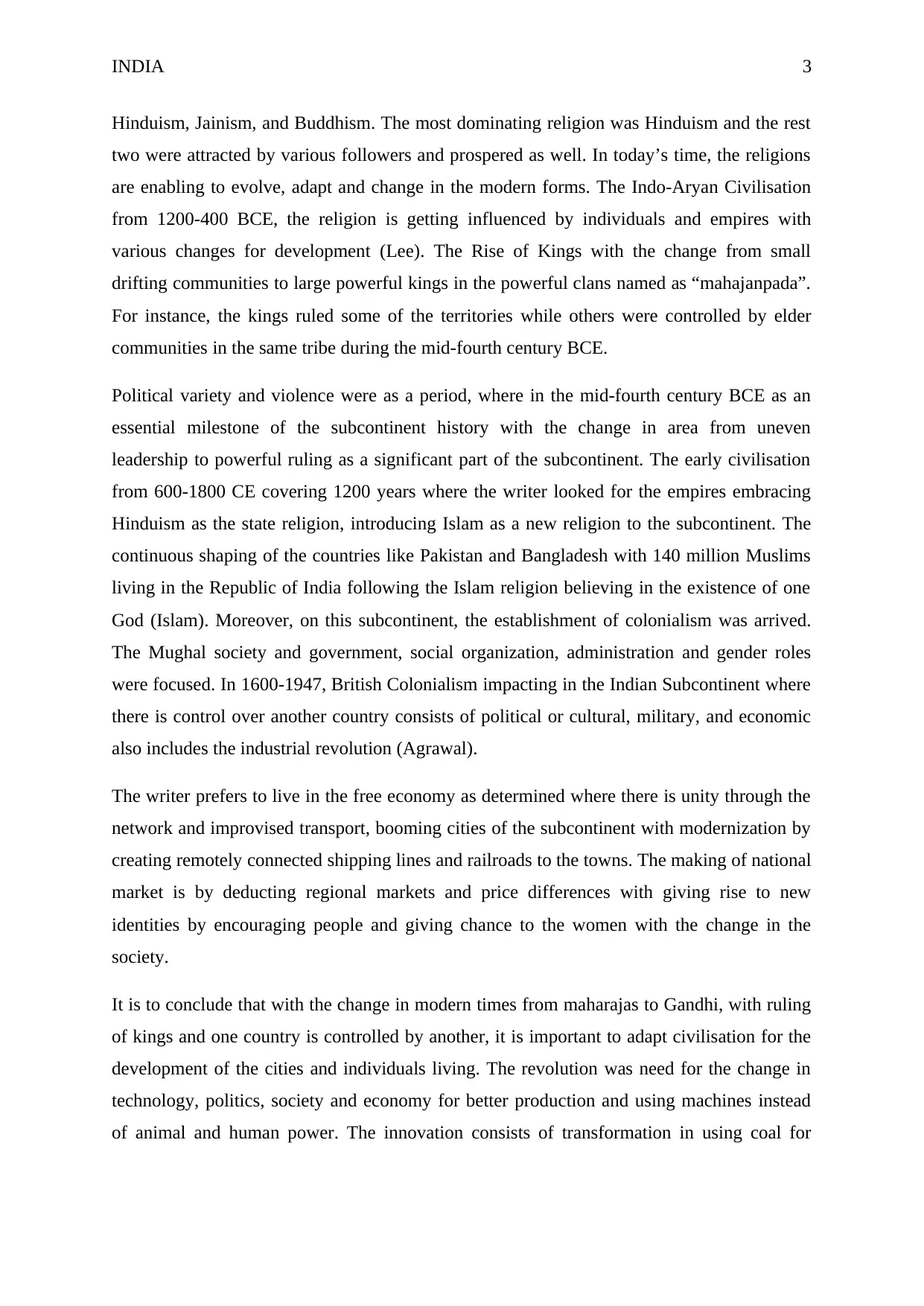
INDIA 3
Hinduism, Jainism, and Buddhism. The most dominating religion was Hinduism and the rest
two were attracted by various followers and prospered as well. In today’s time, the religions
are enabling to evolve, adapt and change in the modern forms. The Indo-Aryan Civilisation
from 1200-400 BCE, the religion is getting influenced by individuals and empires with
various changes for development (Lee). The Rise of Kings with the change from small
drifting communities to large powerful kings in the powerful clans named as “mahajanpada”.
For instance, the kings ruled some of the territories while others were controlled by elder
communities in the same tribe during the mid-fourth century BCE.
Political variety and violence were as a period, where in the mid-fourth century BCE as an
essential milestone of the subcontinent history with the change in area from uneven
leadership to powerful ruling as a significant part of the subcontinent. The early civilisation
from 600-1800 CE covering 1200 years where the writer looked for the empires embracing
Hinduism as the state religion, introducing Islam as a new religion to the subcontinent. The
continuous shaping of the countries like Pakistan and Bangladesh with 140 million Muslims
living in the Republic of India following the Islam religion believing in the existence of one
God (Islam). Moreover, on this subcontinent, the establishment of colonialism was arrived.
The Mughal society and government, social organization, administration and gender roles
were focused. In 1600-1947, British Colonialism impacting in the Indian Subcontinent where
there is control over another country consists of political or cultural, military, and economic
also includes the industrial revolution (Agrawal).
The writer prefers to live in the free economy as determined where there is unity through the
network and improvised transport, booming cities of the subcontinent with modernization by
creating remotely connected shipping lines and railroads to the towns. The making of national
market is by deducting regional markets and price differences with giving rise to new
identities by encouraging people and giving chance to the women with the change in the
society.
It is to conclude that with the change in modern times from maharajas to Gandhi, with ruling
of kings and one country is controlled by another, it is important to adapt civilisation for the
development of the cities and individuals living. The revolution was need for the change in
technology, politics, society and economy for better production and using machines instead
of animal and human power. The innovation consists of transformation in using coal for
Hinduism, Jainism, and Buddhism. The most dominating religion was Hinduism and the rest
two were attracted by various followers and prospered as well. In today’s time, the religions
are enabling to evolve, adapt and change in the modern forms. The Indo-Aryan Civilisation
from 1200-400 BCE, the religion is getting influenced by individuals and empires with
various changes for development (Lee). The Rise of Kings with the change from small
drifting communities to large powerful kings in the powerful clans named as “mahajanpada”.
For instance, the kings ruled some of the territories while others were controlled by elder
communities in the same tribe during the mid-fourth century BCE.
Political variety and violence were as a period, where in the mid-fourth century BCE as an
essential milestone of the subcontinent history with the change in area from uneven
leadership to powerful ruling as a significant part of the subcontinent. The early civilisation
from 600-1800 CE covering 1200 years where the writer looked for the empires embracing
Hinduism as the state religion, introducing Islam as a new religion to the subcontinent. The
continuous shaping of the countries like Pakistan and Bangladesh with 140 million Muslims
living in the Republic of India following the Islam religion believing in the existence of one
God (Islam). Moreover, on this subcontinent, the establishment of colonialism was arrived.
The Mughal society and government, social organization, administration and gender roles
were focused. In 1600-1947, British Colonialism impacting in the Indian Subcontinent where
there is control over another country consists of political or cultural, military, and economic
also includes the industrial revolution (Agrawal).
The writer prefers to live in the free economy as determined where there is unity through the
network and improvised transport, booming cities of the subcontinent with modernization by
creating remotely connected shipping lines and railroads to the towns. The making of national
market is by deducting regional markets and price differences with giving rise to new
identities by encouraging people and giving chance to the women with the change in the
society.
It is to conclude that with the change in modern times from maharajas to Gandhi, with ruling
of kings and one country is controlled by another, it is important to adapt civilisation for the
development of the cities and individuals living. The revolution was need for the change in
technology, politics, society and economy for better production and using machines instead
of animal and human power. The innovation consists of transformation in using coal for
Secure Best Marks with AI Grader
Need help grading? Try our AI Grader for instant feedback on your assignments.
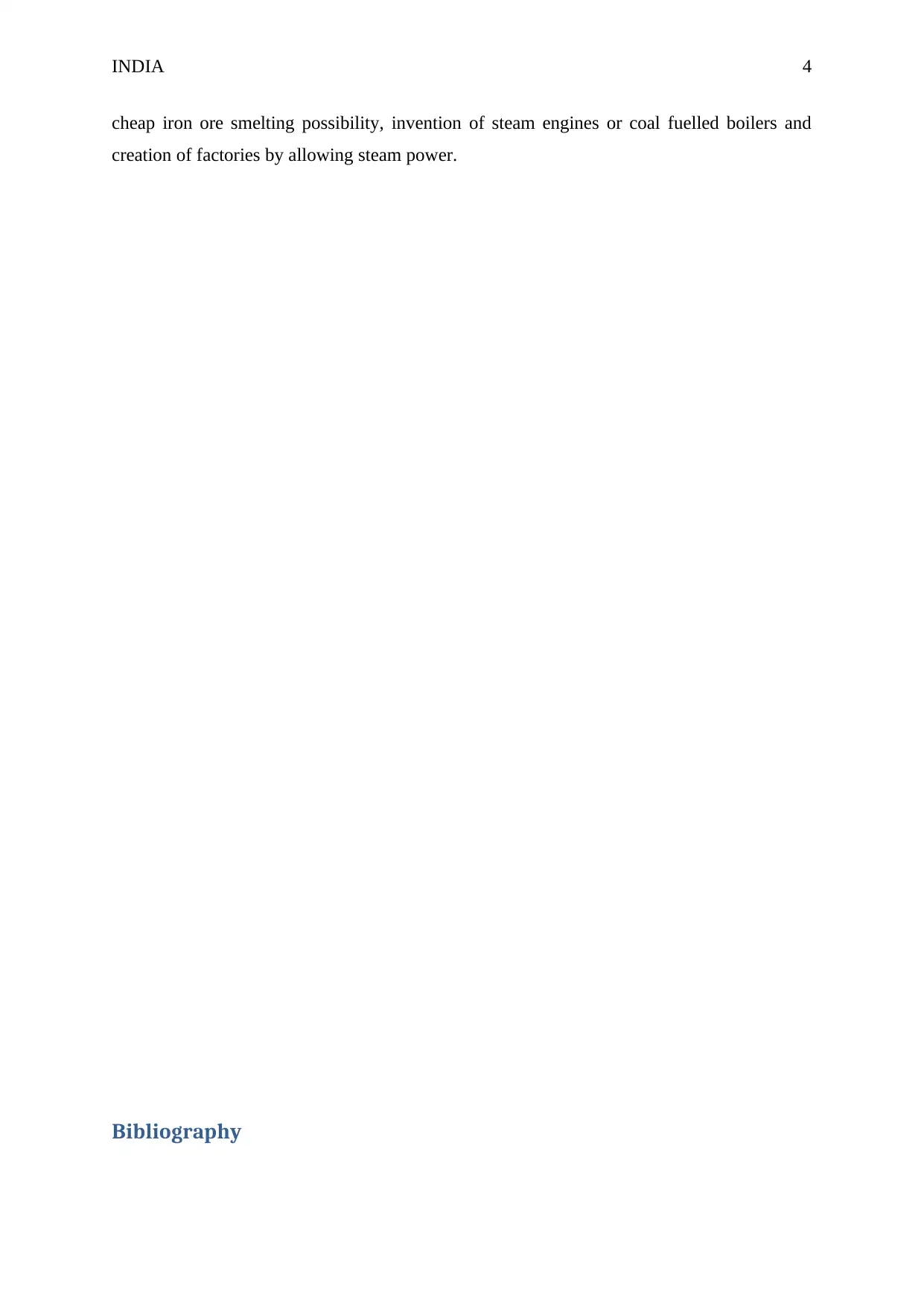
INDIA 4
cheap iron ore smelting possibility, invention of steam engines or coal fuelled boilers and
creation of factories by allowing steam power.
Bibliography
cheap iron ore smelting possibility, invention of steam engines or coal fuelled boilers and
creation of factories by allowing steam power.
Bibliography
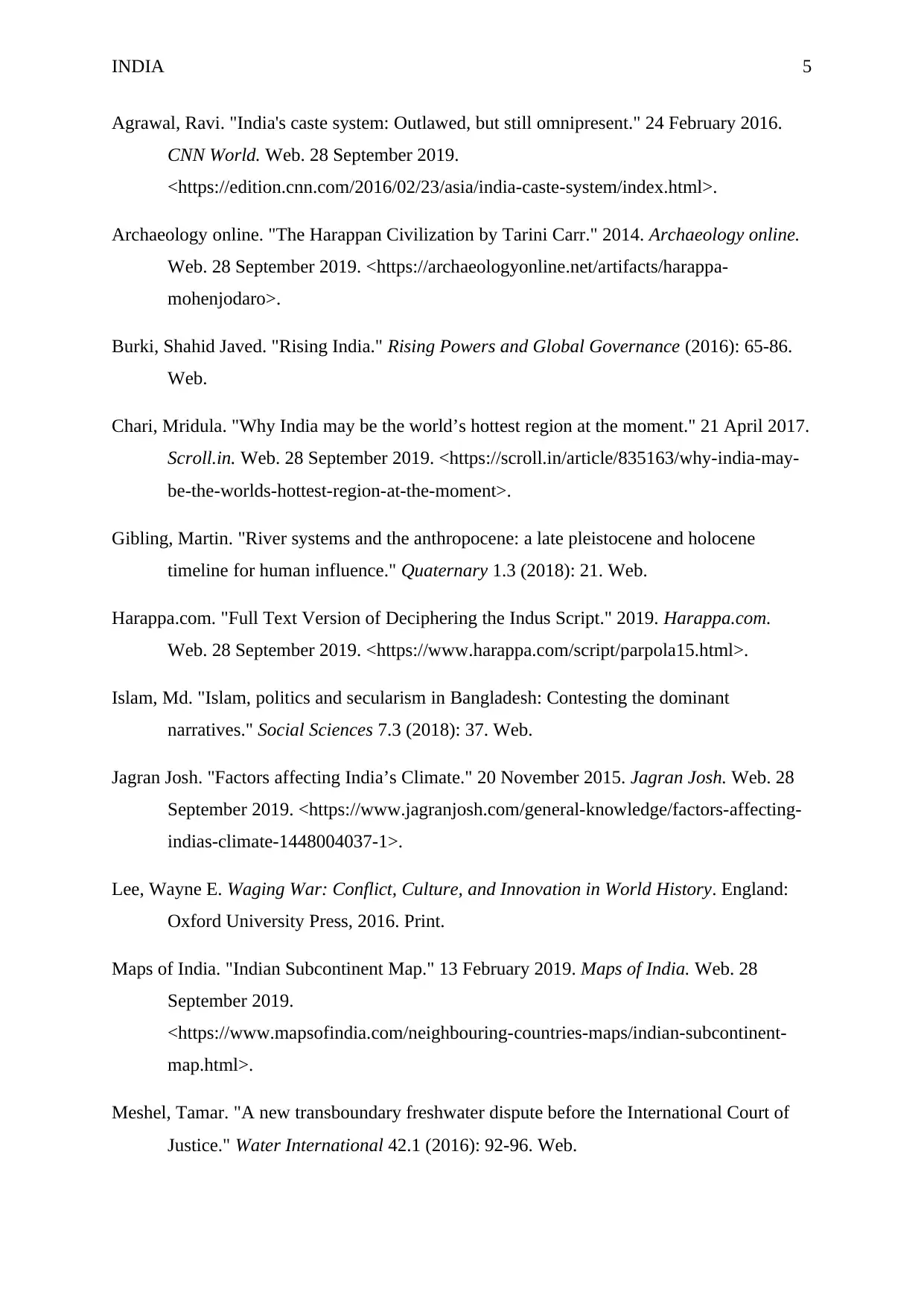
INDIA 5
Agrawal, Ravi. "India's caste system: Outlawed, but still omnipresent." 24 February 2016.
CNN World. Web. 28 September 2019.
<https://edition.cnn.com/2016/02/23/asia/india-caste-system/index.html>.
Archaeology online. "The Harappan Civilization by Tarini Carr." 2014. Archaeology online.
Web. 28 September 2019. <https://archaeologyonline.net/artifacts/harappa-
mohenjodaro>.
Burki, Shahid Javed. "Rising India." Rising Powers and Global Governance (2016): 65-86.
Web.
Chari, Mridula. "Why India may be the world’s hottest region at the moment." 21 April 2017.
Scroll.in. Web. 28 September 2019. <https://scroll.in/article/835163/why-india-may-
be-the-worlds-hottest-region-at-the-moment>.
Gibling, Martin. "River systems and the anthropocene: a late pleistocene and holocene
timeline for human influence." Quaternary 1.3 (2018): 21. Web.
Harappa.com. "Full Text Version of Deciphering the Indus Script." 2019. Harappa.com.
Web. 28 September 2019. <https://www.harappa.com/script/parpola15.html>.
Islam, Md. "Islam, politics and secularism in Bangladesh: Contesting the dominant
narratives." Social Sciences 7.3 (2018): 37. Web.
Jagran Josh. "Factors affecting India’s Climate." 20 November 2015. Jagran Josh. Web. 28
September 2019. <https://www.jagranjosh.com/general-knowledge/factors-affecting-
indias-climate-1448004037-1>.
Lee, Wayne E. Waging War: Conflict, Culture, and Innovation in World History. England:
Oxford University Press, 2016. Print.
Maps of India. "Indian Subcontinent Map." 13 February 2019. Maps of India. Web. 28
September 2019.
<https://www.mapsofindia.com/neighbouring-countries-maps/indian-subcontinent-
map.html>.
Meshel, Tamar. "A new transboundary freshwater dispute before the International Court of
Justice." Water International 42.1 (2016): 92-96. Web.
Agrawal, Ravi. "India's caste system: Outlawed, but still omnipresent." 24 February 2016.
CNN World. Web. 28 September 2019.
<https://edition.cnn.com/2016/02/23/asia/india-caste-system/index.html>.
Archaeology online. "The Harappan Civilization by Tarini Carr." 2014. Archaeology online.
Web. 28 September 2019. <https://archaeologyonline.net/artifacts/harappa-
mohenjodaro>.
Burki, Shahid Javed. "Rising India." Rising Powers and Global Governance (2016): 65-86.
Web.
Chari, Mridula. "Why India may be the world’s hottest region at the moment." 21 April 2017.
Scroll.in. Web. 28 September 2019. <https://scroll.in/article/835163/why-india-may-
be-the-worlds-hottest-region-at-the-moment>.
Gibling, Martin. "River systems and the anthropocene: a late pleistocene and holocene
timeline for human influence." Quaternary 1.3 (2018): 21. Web.
Harappa.com. "Full Text Version of Deciphering the Indus Script." 2019. Harappa.com.
Web. 28 September 2019. <https://www.harappa.com/script/parpola15.html>.
Islam, Md. "Islam, politics and secularism in Bangladesh: Contesting the dominant
narratives." Social Sciences 7.3 (2018): 37. Web.
Jagran Josh. "Factors affecting India’s Climate." 20 November 2015. Jagran Josh. Web. 28
September 2019. <https://www.jagranjosh.com/general-knowledge/factors-affecting-
indias-climate-1448004037-1>.
Lee, Wayne E. Waging War: Conflict, Culture, and Innovation in World History. England:
Oxford University Press, 2016. Print.
Maps of India. "Indian Subcontinent Map." 13 February 2019. Maps of India. Web. 28
September 2019.
<https://www.mapsofindia.com/neighbouring-countries-maps/indian-subcontinent-
map.html>.
Meshel, Tamar. "A new transboundary freshwater dispute before the International Court of
Justice." Water International 42.1 (2016): 92-96. Web.
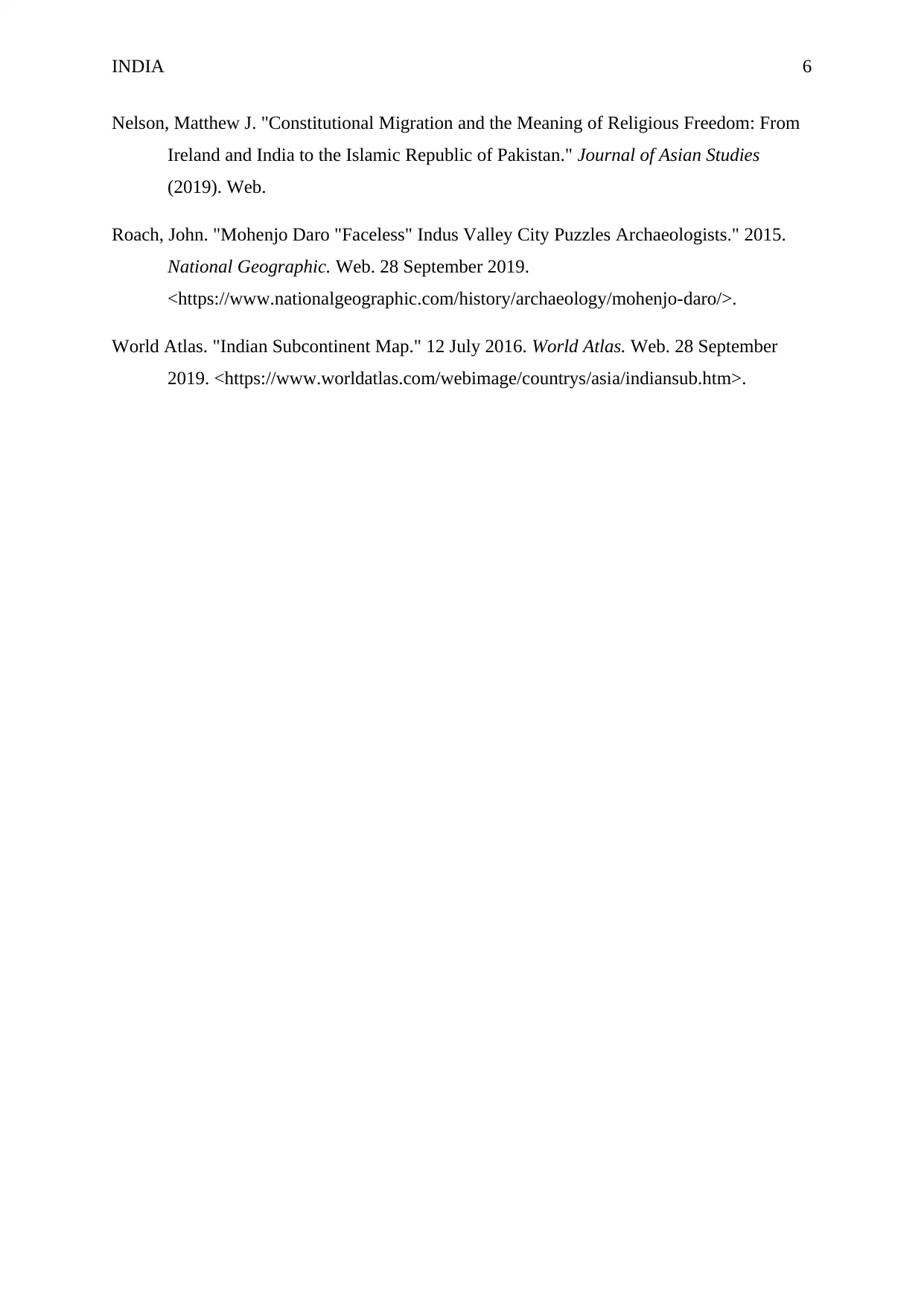
INDIA 6
Nelson, Matthew J. "Constitutional Migration and the Meaning of Religious Freedom: From
Ireland and India to the Islamic Republic of Pakistan." Journal of Asian Studies
(2019). Web.
Roach, John. "Mohenjo Daro "Faceless" Indus Valley City Puzzles Archaeologists." 2015.
National Geographic. Web. 28 September 2019.
<https://www.nationalgeographic.com/history/archaeology/mohenjo-daro/>.
World Atlas. "Indian Subcontinent Map." 12 July 2016. World Atlas. Web. 28 September
2019. <https://www.worldatlas.com/webimage/countrys/asia/indiansub.htm>.
Nelson, Matthew J. "Constitutional Migration and the Meaning of Religious Freedom: From
Ireland and India to the Islamic Republic of Pakistan." Journal of Asian Studies
(2019). Web.
Roach, John. "Mohenjo Daro "Faceless" Indus Valley City Puzzles Archaeologists." 2015.
National Geographic. Web. 28 September 2019.
<https://www.nationalgeographic.com/history/archaeology/mohenjo-daro/>.
World Atlas. "Indian Subcontinent Map." 12 July 2016. World Atlas. Web. 28 September
2019. <https://www.worldatlas.com/webimage/countrys/asia/indiansub.htm>.
1 out of 7
Your All-in-One AI-Powered Toolkit for Academic Success.
+13062052269
info@desklib.com
Available 24*7 on WhatsApp / Email
![[object Object]](/_next/static/media/star-bottom.7253800d.svg)
Unlock your academic potential
© 2024 | Zucol Services PVT LTD | All rights reserved.